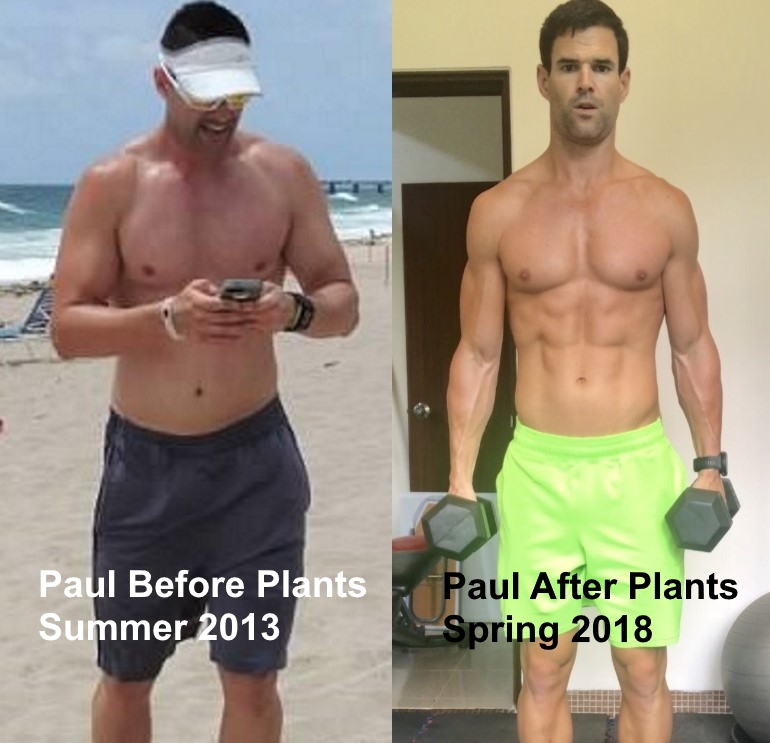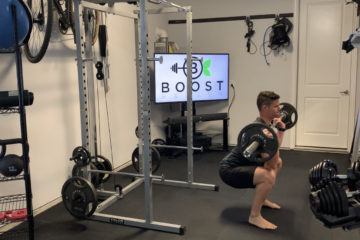
I am going to have some professional pictures taken for BOOST Health later this month. This may come as a surprise but I may not have my shirt on in some of them. Those of you who follow myboosthealth on Instagram and Facebook probably know that is a joke!
The fact is that I take a lot of my workout pictures without a shirt because I want to show I have nothing to hide. I want to show that if you maintain a certain lifestyle, you can have a flat stomach and abdominal definition year round. With that said, I am not going to do anything special to get ready for this photo shoot. No crash dieting, crazy workouts, or water pills. I will just keep doing what I do every day.
I was actually having coffee with my buddy Ric, after a bike ride recently, and he said he didn’t like how he heard a few people say that I am able to keep fit because I don’t have a “real job”. We laughed because we know it requires discipline and effort to have a good physique, and doesn’t necessarily have a direct correlation to whether or not I work a typical office job. In fact, I had the exact same body composition several years ago after I switched to a plant-based diet, and was still working in the corporate world. And nowadays I spend most of my time in front of a computer researching and writing for the blog and podcast. It isn’t as if I am exercising all day long. The truth is, you can have a strong and defined midsection, even if you have a busy career.
When I say defined and flat stomach I am not saying I am super cut up or the most shredded guy in the world. There are plenty of people that have more abdominal definition than I do. Body builders and figure competitors get their body fat down into the low single digits and you can even see vascularity in their abs. While this is impressive, this isn’t something that anyone can, or should, maintain year round. To get to this state there is usually a bulking phase where lots of fat and muscle are added and then a massive cutting phase to get the body fat super low while maintaining as much muscle as possible. These big swings in body composition are not healthy. According to an article on mensjournal.com that discusses negative effects of extremely low body fat, registered dietician Georgie Fear noted that body builders often go below 5% body fat during competition but this is actually too low for a healthy cardiovascular, endocrine, reproductive, skeletal, and nervous system. You can see why they don’t stay in this low zone for very long.
My point is, if you are not a competitive body builder or figure competitor, how about just having a flat tummy and nice abdominal definition year round? There is no need to go to extremes to get and maintain this. Wouldn’t it be nice when swimsuit season comes around and you don’t have to do anything different to be “ready”? It just requires a disciplined lifestyle. In an effort to prescribe this lifestyle to you I have identified below 13 Tactics for Year-Round Abs to Get and Maintain a Flat and Defined Stomach.
One of my goals with BOOST Health is to share ideas to help people find their wellness balance. I know not every tip will work with every individual, but I am hopeful that some of these ideas will work in chorus with what you already know about your body and what works well for you.
1. Have Meaningful Motivation
Believe it or not, my main motivation isn’t really to have 6 pack abs. Defined abs are more a product of something deeper and more meaningful. This meaningful motivation is to avoid or delay getting pancreatic cancer. Those of you who have been following my story know that my father passed away from pancreatic cancer at only 51 years young. I talk about this in my post about becoming a “caveman”, working on all the variables I have control over like food, products, and exercise.
I want to be healthy and live as long as possible for my family. I also have other meaningful motivation including being a good role model to my children, a good mentor to my clients, and a good accountability partner to my training buddies. There is a great quote from the routineexcellence.com website that says “Trying to set good fitness goals without understanding how they are meaningful to you personally is a great way to set weak goals”. I couldn’t agree more.
2. Do FULL BODY Strength Training
If you want abdominal definition, and a functional core, you need to lift heavy stuff in full body movement patterns. Our bodies don’t respond well to target training. Try as you might, your body doesn’t “spot reduce”. Doing 1,000 crunches to make those abs pop just doesn’t work. As I noted in my post on full body training versus split group training, research shows that full body workouts can boost testosterone levels higher and lower cortisol levels as compared to a split group routine. This according to a study in the Biology of Sport Journal in 2016.
Higher testosterone and lower cortisol means more muscle and less fat. If you haven’t tried full body training, this could make a huge difference by itself. You can still do your crunches, but just make sure they are part of an overall full body workout.
3. Try Plant-Based Nutrition
This one was a game changer for me. It was not only massively helpful in changing my physique, but I began to feel like a totally different person. I tell the whole story of how and why I changed to plant-based nutrition in my post on Benefits of Switching to a Plant-Based Diet. The short story is the bloating and stomach pain I was having went away, and now, 4.5 years after starting a plant-based diet I am down about 15 pounds in total mass, have about 10 percent less body fat, and about 5 percent more muscle mass. Needless to say the abdominal definition is much better now and it is also so easy to maintain with this nutrition plan. I know plant-based nutrition isn’t for everyone, but if you haven’t tried it, and you are struggling to see those abs, it may be the missing piece. In the side by side pictures below on the left you can see me in the summer of 2013 before I started plant-based nutrition and beside it a recent picture of me on plants.
4. Listen to Your Body (HRV)
Constantly running the body in an overreaching state is the enemy of defined abs. This is difficult for those of us who train hard and like routines. Yes I am talking to you, fellow OCD sufferer, type-A personality having, protocol junkie. Many of us grew up with sayings like “no pain, no gain” and “go hard or go home”. The problem is that we get really good at becoming numb to what our body is telling us, or trying to tell us. Yes we, as humans, are adaptive creatures. We must push through discomfort to create adaptations to get stronger, faster, better, healthier, etc. But we have to know where the line is that crosses into overreaching and not constantly live there. Sometimes athletes can even go so far and so long into overreaching where they cross into overtraining syndrome. A 2013 study in Medicine and Science in Sports and Exercise noted that overreaching symptoms are the same as overtraining syndrome which include fatigue, performance decline, and mood disturbances.
Clearly if any of those symptoms become chronic, it is time to back off of the training. One that tool that can really be effective at letting you know when you are over doing it with your training is Heart Rate Variability (HRV). I talk about how I use HRV and overlay that data with the Training Peaks TSS score, and hours of sleep to evaluate my recovery, in my post on listening to your body.
In case HRV is a new concept to you, I will provide a quick summary. First, HRV is not the same as heart rate. Heart rate is the number of total beats of your heart in 1 minute. HRV is actually a measurement of the variation of time in between heart beats. Since your heart is controlled by your autonomic nervous system, looking at your HRV can be used as a tool to understand how stressed your body is. I like how firstbeat.com describes HRV in very plain terms:
“Heart rate variability increases during relaxing and recovering activities and decreases during stress. Accordingly, HRV is typically higher when the heart is beating slowly and decreases as the heart beats more quickly. In other words, heart rate and HRV have a generally inverse relationship.”
So we want a high amount of variability in the time between heart beats as this means the heart is beating slower and is less stressed. Can HRV actually help us predict if we are overreaching and overtraining? Yes it can! A 2006 study in in Medicine and Science in Sports and Exercise found that HRV is reduced in athletes that have overtraining syndrome versus the control group.
Staying in a constant overreaching or over-trained state is high stress and cortisol producing. This is not an environment that is good for health or ab definition. Take your HRV every morning and test in the exact same way. Once you have established a good baseline, you will be able to “listen to your body” and, based on the score, decide what the appropriate workout for the day will be.
5. Sleep
A study reviewed on the scientificamerican.com site showed that sleep deprivation can lead to increased cortisol (stress hormone) levels which in turn prompt the body to store more fat and use more muscle for energy. This is not and ideal environment for a flat tummy as you can imagine.
What is the proper amount of sleep? Previously the recommendations on sleep for overall health was a minimum of 7 hours. Now it sounds like we need to shoot for 8 hours. According to a 2017 article on the Popular Science website, the director of the sleep and neuroimaging lab at the University of California, Berkeley, Matthew Walker, says that we actually need a minimum of 8 hours to mitigate reduction of cognitive performance. Apparently anything less than 8 hours puts us in sleep deficit mode and it is not something we can make up for with a couple of long rests over a weekend. Since I recommend fasted morning cardio, going to bed as early as possible is really the best way to get more sleep.
6. Do Some Form of Exercise Daily
This tip is as much about building a habit as it is about following the research. The habit that we are looking to build is exercising every day. The exercise focus and intensity will vary, of course, based on the aforementioned HRV score from that morning and your training schedule. If you have a HRV score that super poor then your exercise may just be light walking or an swim, for example. But it is something. Every day is an exercise day. It is what we do today, tomorrow, and yesterday. We stay active and move every day. From a science backed perspective I talked about effectiveness of frequency of strength and aerobic exercise in my post on the 5 elements of the best overall fitness program.
I included a 2009 study in Phys Sportsmed by Wescott et al, that found that doing aerobic exercise and strength training both 3 times per week yielded greater improvements in body fat percent, fat weight, and lean weight, than only doing them 1 or 2 times per week.
As such, I recommend doing aerobic exercise 4 days per week and full body strength training 3 days per week and alternate days. This is for overall health, but if you want to see some ab definition, then you will want to be on a balanced and consistent program like this.
7. Intermittent Fasting
I cover intermittent fasting in my post 5 nutrition tips for everyone. If you are trying to lose weight and get a lean midsection or just want an easy way to maintain your low body fat percentage, intermittent fasting is a great nutrition strategy to try. According to a 2017 study in the Journal of the International Society of Sports Nutrition, one surprising benefit is that intermittent fasting is just as effective as daily calorie restriction for weight loss.
For those of you who are not big fans of counting every single calorie that you put in your body, this should come as welcome news. Another major benefit of intermittent fasting, according to a 2015 study in Nutrition Reviews, is that individuals lose body fat and maintain muscle better on intermittent fasting plans than daily calorie restriction programs.
There are numerous intermittent fasting methods which I describe in the same post. My favorite is the 12-16 overnight fast. I do this on a daily basis and love it. Give it a try!
8. Fasted Morning Cardio
It is nice to exercise in the morning before the hustle and bustle of the day begins. You also don’t have to worry about energy levels and eating before your workout as you can just train fasted first thing in the morning. Also doing exercise in the morning, specifically cardiovascular exercise in a fasted state, has numerous benefits. A 2010 study in The Journal of Physiology showed that cardiovascular training, cycling and running in this case, in a fasted state is better for preventing weight gain, facilitating muscle adaptations, improving insulin sensitivity, and improving glucose tolerance than exercising in a fed state.
With fasted morning cardio you get your workout for the day done nice and early and you have a better chance of getting or staying lean then if you do cardio later in the day after taking in food.
9. Don’t Let Travel Stop You
Travel can be tough on some folks because it can wreak havoc on your routine. However, with a bit of planning and preparation, traveling can actually enhance your workouts and nutrition with variety. I used to travel a fair amount when I worked in population health management in the US. But I wouldn’t let the travel control my schedule or my food. I would look forward to exercising in a new gym and running on a different trail. I would plan my hotel location so it was close to a good running location near a trail, park, river, lake, etc. I would bring a bunch of bars with me so I wouldn’t be stuck eating something unhealthy. I would ask my clients about good vegan restaurant options and we would even meet there for lunch or dinner sometimes. It can actually be really fun to maintain your wellness routine while traveling with enough planning and the proper mindset.
For family vacations we choose places where we can be active. We like to rent mountain bikes, stand up paddle boards, and kayaks. We also find places that we can run and swim. My wife typically handles our travel logistics and is really kind to always ask for the vegan option for me when purchasing our flights. We have found that the food actually is higher quality in most cases and usually comes out first before the other regular food…so special!
10. Train Your Zones
I cover training in your heart rate zones in great detail in my post on the 5 elements of the best overall fitness program. The general idea is that you want to train at different heart rate ranges when doing cardio to work the different energy systems of the body. This is for various reasons including performance, health, and fat loss. One key type of zone training is High Intensity Interval Training (HIIT). HIIT is especially important for maintaining or creating ab definition because of its fat burning ability. There is a really good article on the University of New Mexico website by Dr. Len Kravitz of the University of New Mexico and Dr. Micah Zuhl of Central Michigan University which discusses HIIT and they noted 2 key studies that show how HIIT can be very effective at burning fat. The first study they mentioned is by Perry et al. in 2008 which showed that fat burning ability of participants was significantly higher after 6 weeks of interval training. The second study was by Talanian et al. in 2007 which showed a significant shift in fatty acid oxidation with HIIT in just 2 weeks. So if you want to burn fat and have a lean midsection, then add some zone cardio training, especially some HIIT, to your routine.
11. Train In a Community
I discussed the many benefits of fitness community and mentorship in my blog and podcast with SIRs founder Bo Kratz and Dragons Committee Member Sheel Kohli on the topic. We discussed a few studies that showed the tremendous improvement in performance. Firstly, in a 2012 study, researchers at Kansas State University found that people who exercised with someone they thought was better than them increased their workout time and intensity by 200 percent.
A 2011 study in the Journal of Sport & Exercise Psychology found that participants were able to hold a plank longer when working with a partner and increased their plank hold by up to 24% when working out with a more capable partner. This ability for a weaker partner or team member to perform better in a group situation than they would on their own is called the Kohler Effect (named after researcher Otto Kohler in late 1920’s discovered)
A 2014 study in the International Journal of Nursing Studies found that older adults who had fitness mentors had higher success in overall retention and participation rates, as well as the best improvements in fitness scores as opposed to the group without mentorship. Interestingly the mentors were broken into several groups including young student mentors and peer mentors, and the mentorship effect was the same.
Keeping your midsection in check requires motivation, accountability, and performing at your best. Being part of a fitness community definitely helps us with all of those and more. Definitely consider joining one if you don’t belong to one already.
12. Keep a Food Journal (Just for a Little While)
I discussed keeping a food journal in my post 5 nutrition tips for everyone. I know it sounds daunting and like a pain in the rear. That is because it is, and also why I suggest only doing it if you are struggling with your nutrition and looking to make a change or if you are trying to identify a food allergy or intolerance. If done properly, it can uncover nutrition habits that may be negatively affecting your health, or possibly point to a particular food or tactic that is working in your favor.
There are lots of different methods and tools for food journaling. You can be very extreme and measure out every gram of food, count each calorie, and log everything into a journal or app. This is a tedious, yet effective method, to understand exactly what you are taking in and whether or not you are creating a calorie deficit, based on your activity level and basal metabolic rate. If you have never looked closely at your nutrition intake, this type of quantitative analysis can be very helpful, even if you just do it for a few days to get rough idea. A 2008 study done by Kaiser Permanente found that individuals who keep a food journal lose 2 times as much weight as those who don’t.
Another method to keeping a food journal is tracking more of the qualitative data that you note with you nutrition intake. This would include how you feel before and after you eat, duration of the meal, whether or not you were hungry when you ate, if your food habits are different based on who you are with, picture of the food, time of day, how long before or after exercise your meal was, etc. I would recommend using a cloud app to house your journal entries as it will allow you to make updates anytime and anywhere as well as add pictures of your meal and add other data points such as heart rate variability score, workout performance, etc. My personal preference is Evernote. Evernote is a well-known productivity app that allows you to make lists, add images, scan documents, etc. and organize everything in a meaningful way. Since you can log in from your smartphone or desktop computer you can easily update on the fly as you eat a meal, get a new idea, or check something off your list. I personally use it for tons of stuff like journaling, lists for grocery store and to-do’s, new ideas I want to capture, recipes, random stuff I want to remember, etc. It is nice not to waste brain space on things that you can quickly access in the palm of your hand. You can download Evernote here for free.
A food journal was imperative to my success when I first switched to a plant-based diet. Here is the link to the post with that full story if you are interested. If you are searching for your abs, or want to maintain them with the best strategy going forward, you should keep a food journal for a few weeks if you haven’t already done so. This will allow you to really tap into what nutrition is serving you best and what might be better to avoid in the future.
13. It is a Lifestyle
Keeping abdominal definition and a flat stomach year round is only possible if you make being healthy a complete lifestyle for yourself. Hopefully it is clear from the list above that there is more involved than fitness and nutrition. It is about an incessant and relentless quest to make the healthiest choices possible for yourself all the time! For example, take the stairs instead of the escalator or elevator, always listen to your body, carry your grocery bags with good posture, be active with your kids, and don’t take time off from your health on vacations or holidays.
I hope this list of tips will help in finding or maintaining your abdominal definition and flat stomach and keep it year round! If you have used any of these tactics with good success I would love to hear about it. Please leave your comments below.
Podcast: Play in new window | Download
Subscribe Apple Podcasts | Google Podcasts | RSS








